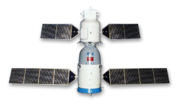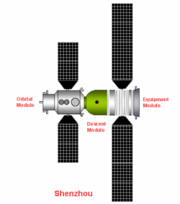Shenzhou spacecraft
2007 Schools Wikipedia Selection. Related subjects: Space transport
Shenzhou (Chinese: 神舟; pinyin: Shén Zhōu) is a spacecraft from the People's Republic of China which first carried a Chinese astronaut into orbit on October 15, 2003. Development began in 1992, with the first four unmanned test flights in 1999, 2001 and 2002. These were followed with another manned launch on October 12, 2005. It is launched on the Long March 2F from the Jiuquan Satellite Launch Centre.
The name is variously translated as "Divine Craft", "Divine Vessel" or similar, but is also a pun on a literary name for China with the same pronunciation (神州; literally "Divine Land")
In March 2005, an asteroid was named 8256 Shenzhou in honour of the spacecraft.
Design
The Shenzhou spacecraft closely resembles the Russian Soyuz spacecraft, although it is substantially larger and features a powered orbital module capable of autonomous flight. This similarity is not surprising; the Chinese have been working closely with the Russians since 1994 and benefited from access both to complete blueprints and full-scale Soyuz spacecraft. Shenzhou is similar to Soyuz for technical reasons — the Soyuz design maximizes volume for a given weight. However, while the basic design is similar, Shenzhou contains no hardware licensed or directly copied from Soyuz.
Like the Soyuz, the Shenzhou consists of three modules: a forward orbital module (轨道舱), a reentry capsule (返回舱) in the middle, and an aft service module (推进舱). This division is based on the principle of minimizing the amount of material to be returned to Earth. Anything placed in the orbital or service modules does not require heat shielding, and this greatly increases the space available to the spacecraft without increasing weight as much as it would if those modules were also able to withstand reentry. Thus both Soyuz and Shenzhou have more living area with less weight than the Apollo Command/Service Module.
The orbital module contains space for experiments, crew-serviced or operated equipment, and in-orbit habitation. The reentry capsule contains seating for the crew, and is the only portion of the Shenzhou which returns to Earth's surface. The shape of the reentry capsule is a compromise between maximizing living space while allowing for some aerodynamic control upon reentry.
The aft service module contains life support and other equipment required for the functioning of the Shenzhou. Two pairs of solar panels, one pair on the service module and the other pair on the orbital module, have a total area of over 40 square metres, indicating average electrical power over 1.5 kW ( Soyuz spacecraft have 1.0 kW).
The orbital module is also equipped with its own propulsion, and control systems, allowing autonomous flight. In the future the orbital modules could also be left behind on the planned Chinese project 921/2 space station as additional station modules. In the unmanned test flights launched so far, the orbital module of each Shenzhou was left functioning in orbit for several days after the reentry capsule's return, and the Shenzhou 5 orbital module continued to operate for six months after launch. Significantly, the docking adapter in the orbital module is based on the adapter used in the Apollo-Soyuz Test Project and is compatible with both Soviet and American docking adapters. It is therefore technically possible for the Shenzhou spacecraft to dock with the International Space Station.
History
China's first efforts at human spaceflight started in 1968 with a projected launch date of 1973. Although China did launch an unmanned satellite in 1970 and has maintained an active unmanned program since, this attempt was cancelled due to lack of funds and political interest.
The current Chinese human spaceflight programme was authorized on April 1, 1992 as Project 921/1, with work beginning on January 1, 1993. The chief designers include Qi Faren and Wang Yongzhi. The first unmanned flight of the spacecraft was launched on November 19, 1999 after which Project 921/1 was renamed Shenzhou, a name reportedly chosen by Jiang Zemin. A series of three additional unmanned flights ensued. The Shenzhou reentry capsules used to date are 13% larger than Soyuz reentry capsules, and it is expected that later craft will be designed to carry a crew of four instead of Soyuz's three.
The fifth launch, Shenzhou 5, was the first to carry a human ( Yáng Lìwěi) and occurred at 9:00 CST (UTC +8) on October 15, 2003.
Like similar space programs in other nations, Shenzhou has been somewhat controversial with some in China questioning whether China should spend money on launching people into space, arguing that these resources would be better directed elsewhere. Indeed, two earlier human spaceflight programs, one in the mid-1970s and the other in the 1980s were cancelled because of expense.
In response, a number of justifications have been offered in the Chinese media. One is that the long term destiny of humanity lies in the exploitation of space, and that China should not be left behind. Another is that such a program will catalyze the development of science and technology in China. Finally, it has been argued that the prestige resulting from this capability will increase China's stature in the world. On October 17, 2005, following the success of Shenzhou 6, Chinese media officially stated that the cost of this flight was around $110 million USD, and the gross cost of Project 921/1 in the past 11 years was $2.3 billion USD, radically lower than the cost of similar space programs in other nations.
The Chinese media has heavily promoted the experiments undertaken by Shenzhou, particularly exposing seeds, including some from Taiwan, to zero gravity and radiation. Most scientists, however, discount the usefulness of this type of experiment, and many have suggested that this is mainly to gain public support for spaceflight from a nation that is still predominantly agricultural.
Some Western news media outlets have suggested that there are important military implications for China's ability to put astronauts into space, specifically in the area of reconnaissance and anti-satellite weaponry. However, the Chinese media has downplayed possible military motivations although Shenzhou's orbital module, staying in orbit for a few months before falling back to earth and disintegrating, is equipped with a high-resolution observation camera, which could be used for military intelligence.
However the experience during the 1960's of both the United States with the Manned Orbiting Laboratory and the Soviet Union with the Almaz space station suggests that the military usefulness of human spaceflight is quite limited and that practically all military uses of space are much more effectively performed by unmanned satellites. Thus while the Shenzhou orbital module could be used for military reconnaissance, there is no military reason for incorporating such as system in a manned mission, as China could use purely unmanned satellites for these purposes.
Missions launched
- Shenzhou 1 - November 19, 1999 - unmanned test flight
- Shenzhou 2 - January 9, 2001 - carrying live test animals
- Shenzhou 3 - March 25, 2002 - carrying a test dummy
- Shenzhou 4 - December 29, 2002 - carried a test dummy, performed several science experiments
- Shenzhou 5 - October 15, 2003 - 14 Earth orbits carrying Yáng Lìwěi
- Shenzhou 6 - October 12, 2005, 5 day mission with Fèi Jùnlóng and Niè Hǎishèng
Planned missions
- Shenzhou 7 - planned for September 2008 with a three man crew; a spacewalk will be the main objective of the mission
- Shenzhou 8 - unmanned mission, will be left in space for docking with Shenzhou 9
- Shenzhou 9 - unmanned mission, will rendezvous and dock with the orbital module of Shenzhou 8.
- Shenzhou 10 - two or three person crew, will dock with Shenzhou 8 and 9
This is similar to the process used by the Soviet Union in their early Soyuz program. It was intended to test procedures for future Lunar flights.

